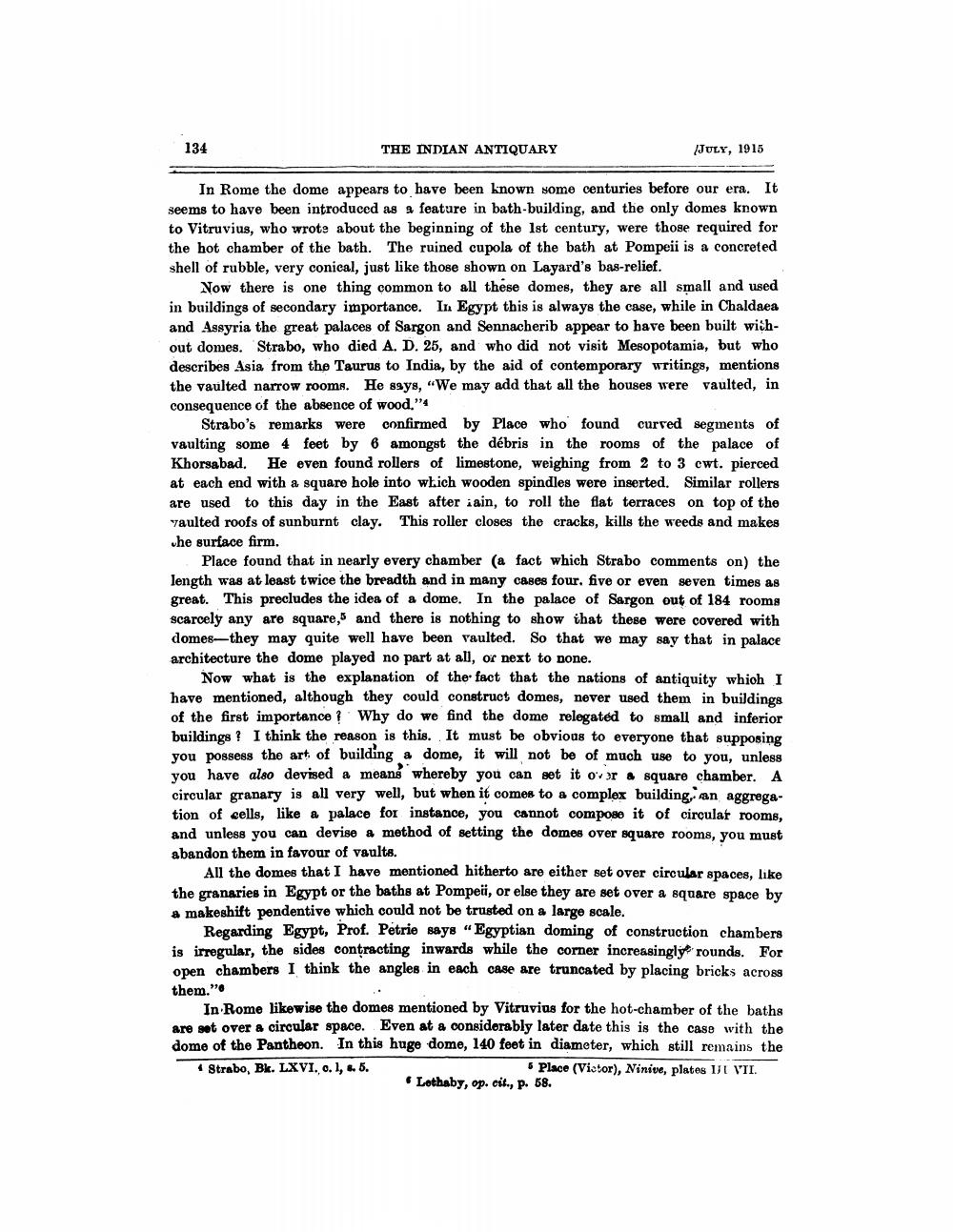________________
134
THE INDIAN ANTIQUARY
{JULY, 1915
In Rome the dome appears to have been known some centuries before our era. It seems to have been introduced as a feature in bath-building, and the only domes known to Vitruvius, who wrote about the beginning of the 1st century, were those required for the hot chamber of the bath. The ruined cupola of the bath at Pompeii is a concreted shell of rubble, very conical, just like those shown on Layard's bas-relief.
Now there is one thing common to all these domes, they are all small and used in buildings of secondary importance. In Egypt this is always the case, while in Chaldaea and Assyria the great palaces of Sargon and Sennacherib appear to have been built without domes. Strabo, who died A. D. 25, and who did not visit Mesopotamia, but who describes Asia from the Taurus to India, by the aid of contemporary writings, mentions the vaulted narrow rooms. He says, "We may add that all the houses were vaulted, in consequence of the absence of wood."
Strabo's remarks were confirmed by Place who found curved segments of vaulting some 4 feet by 6 amongst the débris in the rooms of the palace of Khorsabad. He even found rollers of limestone, weighing from 2 to 3 cwt. pierced at each end with a square hole into which wooden spindles were inserted. Similar rollers are used to this day in the East after iain, to roll the flat terraces on top of the vaulted roofs of sunburnt clay. This roller closes the cracks, kills the weeds and makes he surface firm.
Place found that in nearly every chamber (a fact which Strabo comments on the length was at least twice the breadth and in many cases four, five or even seven times as great. This precludes the idea of a dome. In the palace of Sargon out of 184 rooms scarcely any are square," and there is nothing to show that these were covered with domes-they may quite well have been vaulted. So that we may say that in palace architecture the dome played no part at all, or next to none.
Now what is the explanation of the fact that the nations of antiquity which I have mentioned, although they could construct domes, never used them in buildings of the first importance? Why do we find the dome relegated to small and inferior buildings? I think the reason is this. It must be obvious to everyone that supposing you possess the art of building a dome, it will not be of much use to you, unless you have also devised a means whereby you can set it o r square chamber. A circular granary is all very well, but when it comes to a complex building, an aggregation of cells, like a palace for instance, you cannot compose it of circulat rooms, and unless you can devise a method of setting the domes over square rooms, you must abandon them in favour of vaults.
All the domes that I have mentioned hitherto are either set over circular spaces, like the granaries in Egypt or the baths at Pompeii, or else they are set over a square space by a makeshift pendentive which could not be trusted on a large scale.
Regarding Egypt, Prof. Petrie says "Egyptian doming of construction chambers is irregular, the sides contracting inwards while the corner increasingly rounds. For open chambers I think the angles in each case are truncated by placing bricks across them."
In Rome likewise the domes mentioned by Vitruvius for the hot-chamber of the baths are set over a circular space. Even at a considerably later date this is the case with the dome of the Pantheon. In this huge dome, 140 feet in diameter, which still remains the 4 Strabo, Bk. LXVI. o.1, . 5.
Place (Victor), Ninive, plates UJI VII. Lothaby, op. cit., p. 58.




